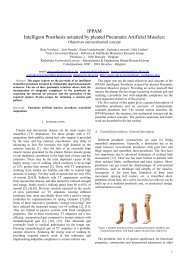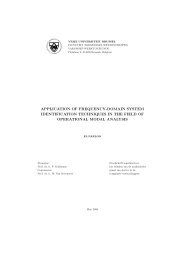VRIJE UNIVERSITEIT BRUSSEL Acoustics - the Dept. of ...
VRIJE UNIVERSITEIT BRUSSEL Acoustics - the Dept. of ...
VRIJE UNIVERSITEIT BRUSSEL Acoustics - the Dept. of ...
You also want an ePaper? Increase the reach of your titles
YUMPU automatically turns print PDFs into web optimized ePapers that Google loves.
4.3. MEASURING THE ACOUSTIC ABSORPTION 73If <strong>the</strong> absorption coefficient a is small (a < 0.25) than a ≈ −ln(1 − a)and equation 4.24 :T = V6SA with A = ∑ ia i S i <strong>the</strong> total absorption (4.27)This last equation is called <strong>the</strong> model <strong>of</strong> Sabine (W.C. Sabine has found thisexpression experimentally [22]).Remark : Above <strong>the</strong>ory belongs to what is called <strong>the</strong> statistical roomacoustics. It gives a certain global image <strong>of</strong> <strong>the</strong> reverberation <strong>of</strong> sound, andis based on many hypo<strong>the</strong>sis and neglects many phenomena, so it does notdeliver full satisfaction to many <strong>the</strong>orists. The result is however useful andpractically well applicable.If <strong>the</strong> volume V and <strong>the</strong> reverberation time T <strong>of</strong> a space is measured, <strong>the</strong>total absorption can be determined with use <strong>of</strong> <strong>the</strong> law <strong>of</strong> Sabine : A = V . 6TFrom this one can determine ā SAB , <strong>the</strong> experimentally determined, averageabsorption coefficient <strong>of</strong> Sabine : ā SAB = A ∑i S i. One may thus assume, thatā SAB is a practically acceptable correct value (keeping in mind that it is aspatial and experimental average, defined by <strong>the</strong> model <strong>of</strong> Sabine). Thusin practice, <strong>the</strong> absorption coefficient shall be experimentally determined forvarious absorbing materials, making use <strong>of</strong> <strong>the</strong> model <strong>of</strong> Sabine. Would we<strong>the</strong>n estimate <strong>the</strong> reverberation time <strong>of</strong> a certain space in which absorbingmaterials are used, it can be done with <strong>the</strong> following practical model:T =V6 ∑ i S ia SAB,i(4.28)wherein <strong>the</strong> values <strong>of</strong> a SAB,i be used which can be found in tables <strong>of</strong> measurementresults. In what follows in this course, we will simplify <strong>the</strong> notationby omitting SAB, in which we however remember that each absorption coefficienta that we encounter, was determined experimentally in <strong>the</strong> mannerdescribed above.Favorablereverberationtimesdependon<strong>the</strong>typeandusage<strong>of</strong><strong>the</strong>rooms:for a furnished living room : 0.5 sec, for a cinema and lecture hall : 0.7-1sec, <strong>the</strong>ater : 0.9-1.3 sec, music hall : 1.7-2.3 sec.In principle, one should not interpret <strong>the</strong>se numbers in a too ’ma<strong>the</strong>matical’manner, as having an absolute value for <strong>the</strong> acoustics <strong>of</strong> a given space.One notes, however, that <strong>the</strong> rooms which have good acoustics, have a Tthat is about within <strong>the</strong> above range. Short reverberation time gives rise to’dry sound’ i.e. sound that does not reverberate because it is immediatelyabsorbed. Several sound (e.g. music) need reverberation for <strong>the</strong>ir subjective
















